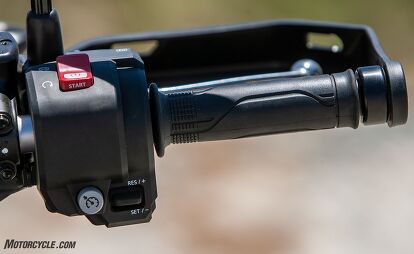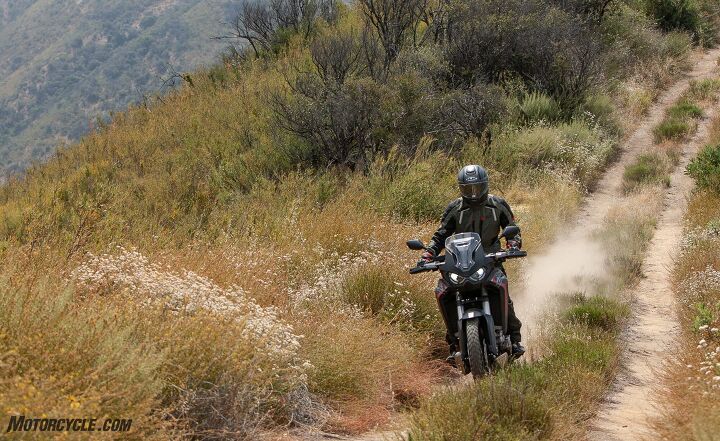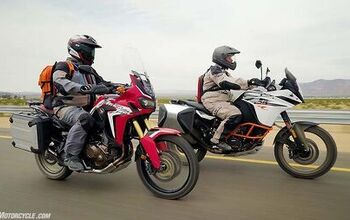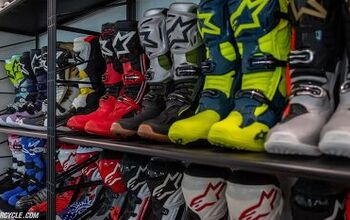2020 Honda Africa Twin Quick Ride Review

You asked, Honda listened
Any motorcycle reviewer will tell you it takes a long ride and several miles to really understand how good – or bad – a motorcycle is. This is especially true when the motorcycle in question is a model refresh and not an entirely new machine. But this might be the first time I can remember where just riding from my house to the stop sign at the end of my street left an impression that would last my entire time with the bike. The updated, 2020 Honda Africa Twin is good. Really good.
Despite the AT’s generally positive reception in 2016, the call for more power is a loud one to ignore. Not that the bike was slow, but when placed against its (bigger) rivals the lack of muscle was apparent. Even on its own, whenever we’ve twisted an Africa Twin’s throttle, excitement and gusto weren’t generally the emotions that followed.
Honda has listened with the new 2020 Africa Twin. The headlining feature, of course, is the larger engine, but Honda took a holistic approach to improving the entire bike, too. We’ve become desensitized to it now, but it seems like whenever a manufacturer gives a model a significant update, the PR buzzwords usually sound something like this:
Bigger
Lighter
Slimmer
And smarter than ever before!
The new Africa Twin follows that playbook to a Tee. Here’s the thing: It really is all of those things. For better or for worse. More on that in a moment.
No Replacement For Displacement
As regular MO readers know, I’ve pigeon-holed myself as the sportbike guy on staff. I don’t mind it, really, but it’s also because, quite frankly, I suck in the dirt. Big ADVs are especially intimidating, which made my Africa Twin assignment all the more daunting. Alas, John and Ryan were busy with other assignments, and Evans is even worse at the dirty stuff than I am. However, trading my leathers for adventure gear has been on my to-do list lately, and while I thought I’d start off on something a lot smaller, the Africa Twin turned out to be an accommodating partner. I’ve ridden the previous Africa Twin, and I have distinct memories of feeling completely ambivalent about the engine. It’s not quite underwhelming, but ambivalence is not a character trait you want in any motorcycle, let alone in an ADV.
This new 1,084cc 270-degree Parallel-Twin is a complete transformation. Not only does it sound kinda throaty even with the stock muffler (and even better with a pipe), but the power hit you feel in your butt is a noticeable improvement from before. As Dennis covered in his 2020 Africa Twin First Look piece, Honda went with a longer stroke (81.5 mm vs. 75.1 mm) to get more cubic centimeters. Bore stays the same as before. As Dennis also notes, the other changes include: a larger throttle body (46mm vs 44mm) and modified air intake for a smoother profile. The ECU was updated, and the fuel injectors were re-angled to more directly spray into the twin-spark combustion chambers. Honda also revised the cylinder head, optimized the valve timing, and increased the intake valve lift to 10.1mm (from 9.2mm) and the exhaust valve lift to 9.3mm (from 8.6mm). The cylinder sleeves are now aluminum, for weight reduction. Honda says the new engine sheds 5.5 lbs with the standard transmission and 4.9 lbs with the DCT. The DCT itself is improved from before thanks to the integration of the Bosch MM7.10 IMU, new for 2020. We opted for the standard transmission this time around for our tester, but a test with the DCT will come later.
These modest improvements don’t sound like much, but from the saddle the AT downright moves the moment you ask it to. Bottom and mid-range torque is much improved from what I remember from the previous Africa Twin. Honda says there’s just a 6% power increase, but boy, what a difference 6% makes. This obviously works out well on the pavement in the first few gears, but you can also take advantage of the extra bump in sixth gear. You don’t need to plan ahead to pass a slower vehicle on the freeway as you did before. Now, if you think it, the Honda will do it. While we had to shift our own gears the old fashioned way, no quickshifters or anything, the gearbox on the Africa Twin is an absolute gem. Each shift is clean and crisp, with a positive engagement. The revised slip-assist clutch is smaller in diameter with reduced spring tension, and the pull at the lever is as light as you could want.
Chassis Changes
Next, Honda turned to the chassis for further weight loss, but more than just slimming it down, Honda engineers aimed to trim down the bike’s dimensions, too. The purpose was two-fold: cutting weight, obviously, but also to revise the AT’s handling characteristics to make it easier to handle off-road.
The entire frame and subframe are changed from before, with several little changes that make up a complete whole. For instance, the steering head twist point has been revised for better front-end feel, the main spars are straighter for better handling under braking, the cross pipe at the main frame is gone for better chassis flex, the pivot plate material is now high-strength steel instead of pressed steel, and the cross tube at the pivot plates is relocated for better feel at the back.
While the changes to the frame are hard to spot with the naked eye, the changes to the subframe are more apparent. For starters, it’s now a bolt-on, removable piece instead of being welded to the main frame. It’s aluminum for weight savings and 40mm narrower at the seat rails – a difference you can see by simply standing behind it. Honda looked to its CRF450R motocross machine for inspiration when redesigning the swingarm of the Africa Twin, too, giving it increased rigidity while also shaving a pound.
When it’s all added together (or should that be subtracted?), Honda says the new Africa Twin tips the scales at 501 lbs and 524 lbs with the standard transmission and DCT, respectively. Both are six-pound reductions from before. Opt for the Adventure Sports version, with electronic suspension, tubeless wheels, a 6.5-gallon fuel tank (versus 5 gallons on the standard), taller screen, slightly larger fairings, along with a host of other little changes we’ll cover in more detail in a future, dedicated test, and weight bumps up to 530 lbs for the standard and 553 lbs for the DCT – both three pounds lighter than before.
Riding It
So, a revised Africa Twin with more power, less weight, and a slimmer profile? By now you’re wondering what it’s like to ride. The answer, as I’ve already alluded to earlier, is very satisfying. Humming along down the highway or around town is a breeze, with gear selection (again, we had the standard transmission this time) a non-issue as there’s enough torque to lug you out of any situation. Sitting in it doesn’t leave you feeling like you’re surrounded by a large adventure machine, built to travel to the deepest corners of the Earth. The seat/tank junction is comfortable for a bike of this size, with the bars understandably high and fairly wide. It’s a neutral and pleasant place to be.
Now is a good time to point out Honda’s separation between the standard Africa Twin and the Adventure Sports, with the former like our tester designed as the more off-road-focused of the two, and the latter geared more towards adventure and touring. As such, standard models have a fixed, shorter windscreen, long-travel analog suspension, and tubed tires. Still, for my 5-foot, 8-inch frame, the low position of the screen wasn’t much of a bother at speed, and the notoriously bad SoCal roads could hardly be felt underneath the fully adjustable Showa suspension – 9.1 inches (front) and 9.4 inches (rear) of travel is plenty to soak up road imperfections.
Since I am the sportbike guy after all, I feel inclined to mention its on-road handling. Considering the 21/18 wheel combo, 27º rake, and 113mm trail, the Africa Twin understandably takes its time bending into corners. Urgency isn’t one of its traits on the road, so just tip it in, stay neutral through the bend, and come out the other side with as little drama as possible. Rinse and repeat until the road goes straight again.
Or, you can use the pavement as a stop-gap between unpaved routes. And while I have to reiterate again how meager my off-road chops are, the Africa Twin inspired loads of confidence to stand up and let the rear get loose.
A Word On Electronics
This confidence comes partially from its easy road manners, but primarily from the biggest addition to the Africa Twin – the inclusion of Bosch’s MM7.10 six-axis IMU. With it, Honda and Bosch have brought the Africa Twin solidly into the digital world, bestowing the advantages that provides, like:
- Cornering ABS
- Honda Selectable Torque Control (HSTC, better known as traction control to the rest of us)
- Rear lift control
- Electronic suspension (on the Adventure Sports)
- DCT cornering detection, wherein the IMU tells the DCT it’s in a corner to adjust where the DCT shifts.
- Cornering lights
- And of course, cruise control! (No, this isn’t IMU-dependent, but is still a huge addition)
Having this kind of safety net really does provide peace of mind to explore your personal limits a little more than you otherwise would. In the case of the Africa Twin, a total of six ride modes (Tour, Urban, Off-Road, Gravel, and two Rider Modes) mix up the power, HSTC, engine brake, ABS, and wheelie control settings, with the rider able to fine-tune any of these settings to their liking in either of the two Rider Modes (one for on-road and one for off-road, as an example).
These modes are adjustable on the fly, assuming the throttle is closed, by simply tapping the up or down arrows on the left grip. Or you can delve deeper into the menus with the touchscreen 6.5-inch TFT display. On the surface, the most basic and often used settings are relatively easy to navigate and manipulate. It’s when you want to get more in-depth that things start to get confusing since you can scroll through the menu screen or push a series of numerous buttons scattered throughout the left and right switchgears.
For example, there are four different power settings, three levels of engine braking, three ABS settings (on-road, off-road, and off), eight levels of traction control (1-7, plus off), and three wheelie control settings. There are even more options if you have the Adventure Sports and/or DCT models. Adding to the intimidation factor are the three different screen displays to choose from (Gold, Silver, and Bronze). Lastly, if you feel inclined to wirelessly connect your phone and/or communicator to the Africa Twin via Bluetooth, the Honda integrates well, but again requires a number of button presses. If all of this sounds daunting, don’t worry – Honda has a series of videos available to walk you through the process. Then again, the need for an online video tutorial kinda says all you need to know about its complexity. I assume if this were your primary bike you’d learn and adapt to the controls. But for those lucky souls who jump on different machines frequently, the learning curve is pretty steep. As it were, it was easy enough to focus on the necessary buttons I’d mostly be using and ignore the rest.
Now Back To The Dirt
Moving from the asphalt to the dirt, some button taps moved me into off-road mode, which then activated off-road ABS (giving relaxed thresholds for activation), softened the power application slightly, and ramped up engine braking. I went in further and lowered the HSTC to its lowest setting because, well, I like kicking the rear end loose (but I still want the bike to protect me from myself if I get carried away).
Once you’re standing on the pegs, the bar placement makes perfect sense. Granted, my well of knowledge when it comes to this sort of thing is limited, but the bars felt perfectly placed in the standing position to allow me to move the bike around to select my line and still work the controls. What’s more, the narrow seat/tank junction that’s a hit while sitting works well when standing to squeeze your knees against the tank. The bolster of the tank towards the top is shaped nicely to rest your upper thighs, too.
Obviously I avoided taking the Africa Twin down any single track, but in the wider off-road expanses I explored, the AT was a gentle dance partner over multiple surfaces. The linear power delivery helped the road-biased tires grip, and when I deliberately poured on the coals, the AT would break loose predictably, with HSTC kicking in far less often than I thought it would.
On the road, the dual 310mm discs can get overwhelmed easily with hard braking, and it’s times like these you’re glad ABS is included. Off-road, there’s enough feel and modularity to descend moderate hills with one finger. Then again, if you’re charging on flat, loose stuff and grab a handful, as I may have done a time or two, the off-road ABS is surprisingly adept at choosing between staying locked or releasing the brakes a smidge. Your mileage may vary of course, as again, I’m not very good at this stuff. But for my measly dirt skills, I found the Africa Twin surprisingly less intimidating than I was expecting.
The Best For Last
Like I said at the start of this, I had an inkling the new Africa Twin would be good as soon as I left my driveway. After riding it on- and off-road some more, those initial good feelings manifested into admiration. This is one good motorcycle. Sure, it might lose out on paper to the major players from BMW and KTM, but the trifecta of more power, a slimmer profile, and modern electronics has raised the Africa Twin’s bar. Besides, it’s a very Honda move to compete not on horsepower, but as a better all-around package.
Is the Africa Twin the best ADV on the market? I doubt it, and I’m sure Ryan would be quick to correct me if I said yes, but for $14,399 for the standard transmission version we tested, it’s sure making a strong case for itself as one hell of a value in the segment. There you go, Africa Twin faithful – you asked, and Honda delivered.
2020 Honda Africa Twin
+ Highs
- Excellent engine/trans combination
- Thoroughly modern electronics
- Strong contender for Value awards
– Sighs
- The menus can get ultra-complicated the deeper you go
- Some more crash protection would be nice
- The horn and turn signal buttons are still switched
In Gear

Helmet: HJC RPHA 90 Tanisk $450-$455
- Jacket: Alpinestars Andes V2 Drystar Jacket $270
- Pants: Alpinestars Men’s Andes V2 Drystar Pants $230
- Gloves: Alpinestars SP-2 v2 Gloves $220
Boots: Alpinestars SP-1 Shoes Discontinued
2020 Honda Africa Twin CRF1100L Specifications | ||||
|---|---|---|---|---|
| Model | Africa Twin Adventure Sports ES DCT | Africa Twin Adventure Sports ES | Africa Twin DCT | Africa Twin |
| Engine Type | 1,084cc liquid-cooled Unicam four-stroke 22.5° parallel-twin | |||
| Valve Train | SOHC; four valves per cylinder | |||
| Bore x Stroke | 92.0mm x 81.5mm | |||
| Compression Ratio | 10.1:1 | |||
| Induction | PGM-FI electronic fuel injection w/ 46mm throttle bodies (Throttle By Wire) | |||
| Ignition | Full transistorized ignition | |||
| Starter | Electric | |||
| Transmission | 6 speed automatic DCT | 6 speed manual | 6 speed automatic DCT | 6 speed manual |
| Clutch | (2) multiplate wet | Multiplate wet | (2) multiplate wet | Multiplate wet |
| Final Drive | 525 Chain | |||
| Front Suspension | 45mm inverted Showa telescopic fork w/ EERA; 9.1 inches travel | 45mm inverted Showa telescopic fork; 9.1 inches travel | ||
| Rear Suspension | Pro-Link system w/ single Showa shock w/ EERA; 9.4 inches travel | Pro-Link system w/ single Showa shock; 9.4 inches travel | ||
| Front Brakes | Two four-piston hydraulic calipers w/ 310mm disks; ABS | |||
| Rear Brakes | Single one-piston hydraulic caliper w/ 256mm disk; ABS | |||
| Front Tires | 90/90-21 | |||
| Rear Tires | 150/70R-18 | |||
| Rake | 27.0° | |||
| Trail | 113mm (4.4 inches) | |||
| Length | 91.7 inches | |||
| Width | 37.9 inches | 37.7 inches | ||
| Height | 61.5 inches | 55.0 inches | ||
| Seat Height | 34.3 inches / 33.7 inches | |||
| Ground Clearance | 9.8 inches | |||
| Wheelbase | 62.0 inches | |||
| Fuel Capacity | 6.5 gallons | 5.0 gallons | ||
| Color | Pearl Glare White/Blue | Matte Black Metallic | ||
| Curb Weight | 553 lbs. (claimed) | 530 lbs. (claimed) | 524 lbs. (claimed) | 501 lbs. (claimed) |

Troy's been riding motorcycles and writing about them since 2006, getting his start at Rider Magazine. From there, he moved to Sport Rider Magazine before finally landing at Motorcycle.com in 2011. A lifelong gearhead who didn't fully immerse himself in motorcycles until his teenage years, Troy's interests have always been in technology, performance, and going fast. Naturally, racing was the perfect avenue to combine all three. Troy has been racing nearly as long as he's been riding and has competed at the AMA national level. He's also won multiple club races throughout the country, culminating in a Utah Sport Bike Association championship in 2011. He has been invited as a guest instructor for the Yamaha Champions Riding School, and when he's not out riding, he's either wrenching on bikes or watching MotoGP.
More by Troy Siahaan












































































Comments
Join the conversation
The article covered the updates and their effect in detail. Well done Troy!
This is a really well focused and worthy upgrade by Honda. The AT has always been the approachable "easy" big ADV bike. Now it is a much better "easy" big ADV bike. The great thing is Honda improved the AT without taking away any of it's "easy" factor. For someone more focused on off road but still wanting "easy" in a bike that can cover miles on the road, Yamaha will be happy to sell you a T7. It is a great time to be into ADV bikes!
I do think the manufacturers have lost their minds on the heavyweight end of the ADV market - more power, more weight, more complexity, more cost. As a result, we have expensive, huge, powerful and imposing ADV bikes. Take BMW's R1200 GS bikes for example. Is that thing an ADV bike or a Panzer tank? I may be an American, so "more is better" is almost a religion, but more is not always better. The Africa Twin displays intelligent balance and restraint, and it is "enough".
The AT is a broad band kind of bike that can accommodate someone like Troy, who is an accomplished pavement guy but not as comfortable off road, and it is also a great bike for the discerning customer who has a dirt bike background like me. I could get on the AT off road, turn off the nannies and lift a wheelie, slide around, try some inadvisablely steep terrain and otherwise have some actual off road fun on it. I would not be comfortable doing those shenanigans on a big heavy and painfully expensive GS.
Well done Honda. I am a fan.
What's with this turn signal horn button thing, and who came up with that idea?
That is almost like reversing a gas and brake pedal in a car, you don't do it. I experienced the horn button reversal on a Honda for several thousand miles and still had a hard time getting used to it and ultimately never did!